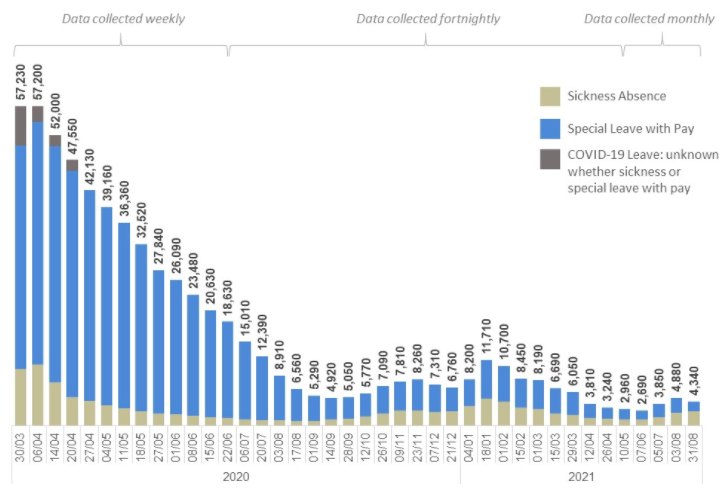Nearly one in eight civil servants were absent from work at the peak of the Covid crisis for reasons related to the virus, the latest stats have revealed.
Figures dating back to 30 March last year and published yesterday show 13% of officials were absent on that day because they were directly or indirectly hit by coronavirus. The stats record weekly Covid-related absence up to June 2020, then fortnightly up to May this year, and monthly thereafter.
Most of the group who were ill last March – 9% of all officials – had been granted special leave with pay as they had to miss work due to office or service closures, self-isolation, quarantine or caring responsibilities.
The figures peaked at the end of March 2020, shortly after initial lockdown measures were implemented, when 57,230 civil servants were absent because of Covid. The vast majority were granted special leave as offices and workers scrambled to adjust to work from home requirements, as well as caring and home-schooling requirements.
The most recent civil service sickness absence report, pubished in January, showed Covid accounted for just 2.5% of short-term sickness absence in 2019-20. However, those figures only run up to the end of March 2020, and so yesterday's Covid-specific figures show the percentage for this year is likely to be higher.
Official Covid-related sickness absence peaked in early April, with 10,890 civil servants off showing symptoms of the virus – 2.4% of the entire workforce – up from 10,110 the week before.


Covid-19 related absences in the civil service: March 2020-August 2021. Source: GOV.UK
However, the figures also show improvements in reporting types of absence since those early months of the pandemic, with 7,160 instances of unspecified Covid leave logged in March and 2,840 in early April.
"In earlier weeks of reporting, not all organisations were able to map Covid-19 related absences as either sickness or paid special leave, therefore some absence falls within ‘Covid-19 leave: unknown’ during these weeks," the report notes.
Absences of both kinds then decreased consistently up to last September – following national trends – but began to rise again in October. The shift coincided with a quickly-aborted plan by ministers to push civil servants who had been working from home amid the pandemic to return to offices. The plan was scrapped amid rising infections nationally.
Absences peaked again in January this year, but at a much lower 11,710. They have once again declined steadily before beginning to climb back up again in July.
The data only runs up to August, but national figures have shown coronavirus infection rates are climbing. Infections hit 50,000 for the first time in three months this week, and death rates are also rising.
The Cabinet Office noted there had been far lower rates of special leave granted in the second and third waves of the pandemic, which it attributed to the civil service’s “improved ability to adapt to the disruption”.